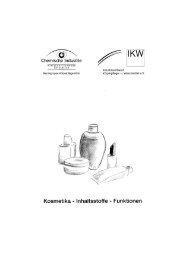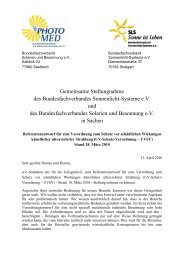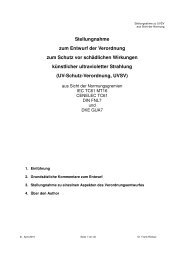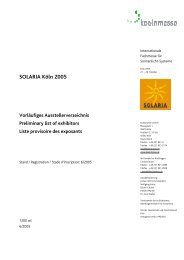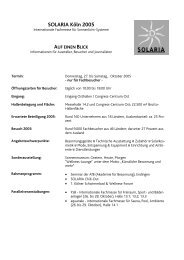2006;56;106-130 CA Cancer J Clin Smigal and Michael J. Thun ...
2006;56;106-130 CA Cancer J Clin Smigal and Michael J. Thun ...
2006;56;106-130 CA Cancer J Clin Smigal and Michael J. Thun ...
You also want an ePaper? Increase the reach of your titles
YUMPU automatically turns print PDFs into web optimized ePapers that Google loves.
<strong>CA</strong> <strong>Cancer</strong> J <strong>Clin</strong> <strong>2006</strong>;<strong>56</strong>:<strong>106</strong>–<strong>130</strong><br />
TABLE 11 Probability of Developing Invasive <strong>Cancer</strong>s Within Selected Age Intervals, by Sex, US, 2000<br />
to 2002*<br />
70 <strong>and</strong> Birth to<br />
Birth to 39 40 to 59 60 to 69 Older Death<br />
(%) (%) (%) (%) (%)<br />
All sites† Male 1.43 (1 in 70) 8.57 (1 in 12) 16.46 (1 in 6) 39.61 (1 in 3) 45.67 (1 in 2)<br />
Female 1.99 (1 in 50) 9.06 (1 in 11) 10.54 (1 in 9) 26.72 (1 in 4) 38.09 (1 in 3)<br />
Urinary bladder Male .02 (1 in 4375) .40 (1 in 250) .93 (1 in 108) 3.35 (1 in 30) 3.58 (1 in 28)<br />
Female .01 (1 in 9513) .12 (1 in 816) .25 (1 in 402) .96 (1 in 104) 1.14 (1 in 88)<br />
Breast Female .48 (1 in 209) 4.11 (1 in 24) 3.82 (1 in 26) 7.13 (1 in 14) 13.22 (1 in 8)<br />
Colon & rectum Male .07 (1 in 1399) .90 (1 in 111) 1.66 (1 in 60) 4.94 (1 in 20) 5.84 (1 in 17)<br />
Female .06 (1 in 1<strong>56</strong>7) .70 (1 in 143) 1.16 (1 in 86) 4.61 (1 in 22) 5.51 (1 in 18)<br />
Leukemia Male .15 (1 in 650) .22 (1 in 459) .35 (1 in 284) 1.17 (1 in 85) 1.50 (1 in 67)<br />
Female .13 (1 in 788) .14 (1 in 721) .19 (1 in 513) .78 (1 in 129) 1.07 (1 in 93)<br />
Lung & bronchus Male .03 (1 in 3244) 1.00 (1 in 100) 2.45 (1 in 41) 6.33 (1 in 16) 7.58 (1 in 13)<br />
Female .03 (1 in 3103) .80 (1 in 125) 1.68 (1 in 60) 4.17 (1 in 24) 5.72 (1 in 17)<br />
Melanoma of the skin Male .13 (1 in 800) .51 (1 in 195) .51 (1 in 195) 1.25 (1 in 80) 1.94 (1 in 52)<br />
Female .21 (1 in 470) .40 (1 in 248) .26 (1 in 381) .<strong>56</strong> (1 in 178) 1.30 (1 in 77)<br />
Non-Hodgkin lymphoma Male .14 (1 in 722) .47 (1 in 215) .<strong>56</strong> (1 in 178) 1.57 (1 in 64) 2.18 (1 in 46)<br />
Female .09 (1 in 1158) .31 (1 in 320) .42 (1 in 237) 1.29 (1 in 77) 1.82 (1 in 55)<br />
Prostate Male .01 (1 in 10149) 2.66 (1 in 38) 7.19 (1 in 14) 14.51 (1 in 7) 17.93 (1 in 6)<br />
Uterine cervix Female .15 (1 in 657) .28 (1 in 353) .15 (1 in 671) .22 (1 in 464) .74 (1 in 135)<br />
Uterine corpus Female .06 (1 in 1641) .72 (1 in 139) .83 (1 in 120) 1.36 (1 in 74) 2.61 (1 in 38)<br />
*For those free of cancer at beginning of age interval. Based on cancer cases diagnosed during 2000 to 2002. The “1 in”<br />
statistic <strong>and</strong> the inverse of the percentage may not be equivalent due to rounding.<br />
†All sites excludes basal <strong>and</strong> squamous cell skin cancers <strong>and</strong> in situ cancers except urinary bladder.<br />
Source: DevCan Software, Probability of Developing or Dying of <strong>Cancer</strong> Software, Version 6.0. Statistical Research <strong>and</strong><br />
Applications Branch, National <strong>Cancer</strong> Institute, 2005. http://srab.cancer.gov/devcan.<br />
ferences in comorbidities. The extent to which<br />
these factors, individually or collectively, contribute<br />
to the overall differential survival is unclear.<br />
16 However, recent findings suggest that<br />
African Americans who receive similar cancer<br />
treatment <strong>and</strong> medical care as Whites experience<br />
similar outcomes. 17<br />
There have been notable improvements<br />
over time in relative five-year survival rates<br />
for many cancer sites <strong>and</strong> for all cancers<br />
combined (Table 12). This is true for both<br />
Whites <strong>and</strong> African Americans. However,<br />
5-year relative survival is still very poor (less<br />
than 25%) for many cancers, including pancreas,<br />
liver, esophagus, lung, <strong>and</strong> stomach.<br />
Relative survival rates cannot be calculated<br />
for other racial <strong>and</strong> ethnic populations because<br />
accurate life expectancies are not available.<br />
However, based on cause-specific survival rates<br />
of cancer patients diagnosed from 1992 to 2000<br />
in SEER areas of the United States, all minority<br />
populations, except Asian/Pacific Isl<strong>and</strong>er<br />
women, have a greater probability of dying<br />
from cancer within 5 years of diagnosis than<br />
non-Hispanic Whites after accounting for differences<br />
in age at diagnosis. 18,19 For the four<br />
major cancer sites (prostate, female breast, lung<br />
<strong>and</strong> bronchus, <strong>and</strong> colon <strong>and</strong> rectum), minority<br />
populations are more likely to be diagnosed at<br />
distant stage, compared with non-Hispanic<br />
Whites. 19<br />
<strong>CA</strong>NCER IN CHILDREN<br />
<strong>Cancer</strong> is the second leading cause of death<br />
among children between the ages of 1 <strong>and</strong> 14<br />
years in the United States; accidents are the most<br />
frequent cause of death in this age group (Table<br />
13). The most common cancers in children (0 to<br />
14 years) are leukemia (particularly acute lymphocytic<br />
leukemia), cancer of the brain <strong>and</strong> other<br />
nervous system, soft tissue sarcomas, non-<br />
Hodgkin Lymphoma, <strong>and</strong> renal (Wilms) tumors.<br />
3 Over the past 25 years, there have been<br />
significant improvements in the 5-year relative<br />
survival rate for many childhood cancers (Table<br />
14). The 5-year relative survival rate among children<br />
for all cancer sites combined improved from<br />
Downloaded from caonline.amcancersoc.org by guest on September 27, <strong>2006</strong> (©American <strong>Cancer</strong> Society, Inc.)<br />
Volume <strong>56</strong> Y Number 2 Y March/April <strong>2006</strong> 123



![811 IARC vitamin D and Cancer Report_VitD[1] - Sunlight Research ...](https://img.yumpu.com/25304592/1/184x260/811-iarc-vitamin-d-and-cancer-report-vitd1-sunlight-research-.jpg?quality=85)
